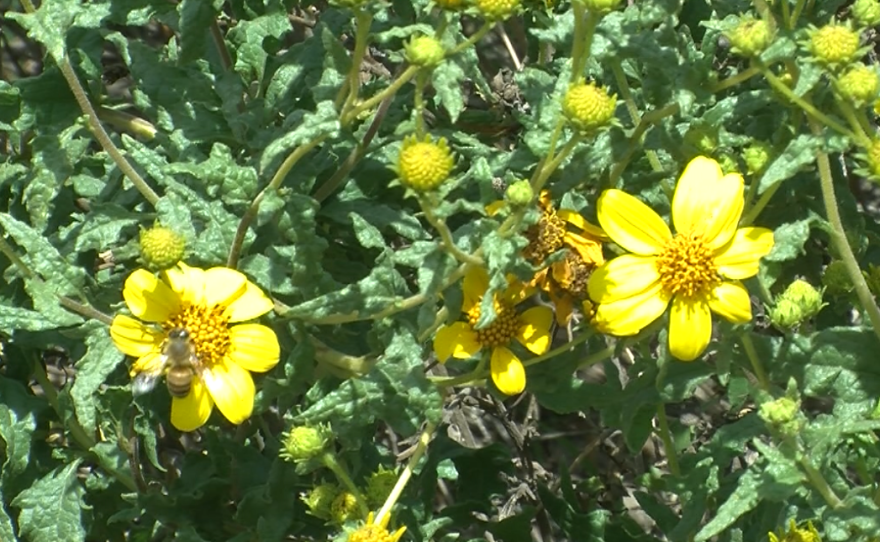And Eagle State University researchers are trying to gain desk age how the ecosystems are shifting as climate change affects local habitats. Some answers may come from the insects that serve key roles for native plants. Eric Anderson has details. The flowers that bloom so brightly in Southern California are part of a complex puzzle that could help researchers piece together the local impact of climate change. He spent the past couple of years collecting pollinators that populate a small slice of Mission Trails Regional Park. He says it is not just about these. They can easily be 20 different species of bees. I know there are several different species of beetles that feed on the flowers and could be potential pollinators as well. I've seen four are five different butterfly species fly bias. He says it's important to know how the local insect populations are doing and the best way is to set traps and count them. He is hopeful they will find a baseline measurement for population that play such an important role in keeping wild areas thriving. He says there are more questions right now than answers. We know there are differences in the community composition so why does not matter? We want to see how that is impacting pollination rates, decomposition rates so we have a better understanding of these issues. It may lead to more active involvement in restoration. He's collected mostly flies, bees, and wasps but there are others that end up in the traps. It these are Argentinian and so estimating about 1000 of them from just one single trap that was about 60s long. Recollecting, measuring, and cataloging they six tells them about the population health. Douglas Duetsschman says it till site is about the health of the environment where the bugs are caught her cohesive starting pollinators is not new they serve a key role in sustaining the nations agricultural industry but he's a starting pollinators have been largely ignored. What we fail to remember is that same issue happens in the natural world that are native plants also need to be pollinated often by native insects. He says the natural environment offers a chance to study an incredibly diverse insect population. Some insects are specialist and only only one kind of flour. All of the need to be understood. If we don't understand pollination and more natural environments we may be losing valuable services that the systems provide an we have tremendous impact on around. Learning what the complex relationship some tracking populations overtime will give researchers insight into a world they know very little about. That could inform efforts to save plans that are on the brink of extinction especially if they are ready know that the pollinators are gone. No amount of preserving the rain for the plant will protect it from extinction if the polymers dust pollinators are driven on the system. Warming temperatures can impact insect populations and change the capacity to serve local habitats. That is the reason why the San Diego foundation is helping to fund the research. They say there is value and more about our natural world. Are you talking about some of the natural areas? We get a better understanding of how the populations are changing and how they might in turn affect the health of our local vegetation as well as pollinate. They've also fund two rounds of starting. -- Studying.
The flowers that bloom so brightly in Southern California are part of a complex puzzle that could help researchers piece together the local impact of climate change.
San Diego State University biologist Daniel Marschalek spent the past couple of years collecting pollinators that populate a small slice of Mission Trails Regional Park.
He tracked more than just bees.
Insects may inform about climate change
"There could easily be 20 different species of bees. I know there's several different species of beetles that feed on the flowers and could be potential pollinators. And yeah, I've seen four or five different butterfly species fly by us just in the last 10 minutes," Marschalek said.
Researchers contend it is important to know how local insect populations are doing and the best way to do that is set traps and count them.
What scientists find out will help establish baseline measurements for a population that plays an important role in keeping wild areas thriving.
Right now there are more questions than answers.
"We know that there's differences in the community composition, and so how does that matter," Marschalek said. "We want to see how that's impacting pollination rates, decomposition rates — so we have a better understanding of these issues. And it may lead to more active involvement in restoration."
Marschalek is collecting mostly flies, beetles, bees and wasps, but he says there are other interlopers that end up in his traps. Back in his lab, he holds up a small vial.
"These are Argentine ants, so we're estimating about 1,000 of them. From one single trap that was about six days long," Marschalek said.
Collecting, measuring and cataloguing the insects tells researchers about a population's health.
San Diego State University entomologist Douglas Duetschman said that information also tells scientists about the health of the environment where the bugs were caught.
Studying pollinators is not new, the insects serve a key role in sustaining the nation's billion-dollar agricultural industry. But Duetschman said studying pollinators in native habitats has largely been ignored.
"What we fail to remember is that same issue happens in the natural world. Our native plants and ecosystems that they depend on also need to be pollinated. Often by native insects that we know very little about," Duetschman said.
Pollination critical in natural habitat
The natural environment offers the chance to study an incredibly diverse insect population. Some insects are specialists and only pollinate one kind of flower. Others are generalists. All of them need to be understood.
"If we don't understand pollination both in agricultural and in more natural environments we may be losing really valuable services that ecosystems provide and that may have tremendous impacts down the road," Duetschman said.
Learning about those complex relationships and tracking populations over time will give researchers insight into a world they know little about.
That could inform efforts to save plants that are teetering on the brink of extinction, especially if officials already know the native pollinators are gone.

"No amount of preserving the land for that plant will protect the plant from extinction if its pollinator is driven out of the system. So we need to start thinking about the system, not just the piece of land we're protecting," Duetschman said.
Warming temperatures could impact insect populations and change their capacity to serve local habitats. That's one reason the San Diego Foundation is helping fund the research.
"Whether you're talking about Mission Trails Regional Park or you're talking about Otay Valley Regional Park, or you're talking about some of the natural areas in the North County. We can get a better understanding of how those populations are changing and how they might in turn affect the health of our local vegetation as well as cropland," said Emily Young of the San Diego Foundation.
The foundation has already supported two rounds of the study. That's helping local researchers build a baseline that they can use to measure future change.






